Clark sets a course to achieve the possible

In his December 15 State of the University address, President David Fithian noted that Clark University has long accomplished impressive things despite limited resources, an effort that is admirable and unselfish, but one that is ultimately unsustainable.
“The more we say ‘We can’t do that,’ the more it becomes a self-fulfilling prophecy, to the point where ‘We can’t do that’ becomes ‘We won’t do that.’ Clark has reached a critical juncture where our culture of austerity must give way to a culture of possibility,” he said.

Envisioning, shaping, and turning those possibilities into realities lies at the heart of Clark’s comprehensive strategic planning process. Once completed, the University’s Strategic Framework will become Clark’s reference for preparing students to live and work in a rapidly changing world, supporting faculty in their research and creative endeavors, and positioning the University to thrive in an increasingly competitive higher education landscape.
The origin of this work dates to the 2019–20 academic year, when the faculty’s Planning and Budget Review Committee spearheaded an onboarding process for Clark’s new president, creating a 135-page comprehensive, living document, “Academic Units at Clark 2020.” That work became a bridge to the developing framework, which is inspired by the institution’s rich heritage, particularly its shared mission and values. It expands and elevates the University’s aspirations, and empowers the University to fulfill them.
Toward that goal, the administration initiated community-wide conversations to capture fresh ideas and consider new approaches for the institution’s progress. A series of “visioning” events were held with Clark faculty, staff, and students to conceptualize key elements of the University’s future with members of its community, including the many ways the principles of diversity, equity, and inclusion will underscore and gird all of Clark’s strategic planning and become an essential through-line for the institution’s efforts.
This summer, the Visioning phase will transition to the Focus phase. In this stage of the process, the Strategic Framework Steering Committee, chaired by David Chearo, vice president for planning and strategic initiatives, is accepting and will evaluate submitted ideas as a step toward articulating and refining the University’s vision for its future. The committee will begin evaluating submissions on an ongoing basis through July. Those with a Clark log-in can submit ideas using this form.
By fall, the Strategic Framework will clarify a shared mission, values, and vision; identify institutional goals and key performance indicators; and serve as a compass for decision-making and planning. To develop the framework, Clark is focusing on five priority areas for new programs, investments, and partnerships:
- Academic programs and research: Fostering academic excellence by leveraging traditional strengths and building new ones.
- Culture and identity: Ensuring Clark lives up to its values as an inclusive and equitable institution and nurtures a new, emboldened culture of possibility.
- Campus experience: Promoting a sense of belonging, shared community, and vibrant campus life; and enhancing Clark’s physical campus to inspire and enable the best work of faculty, students, and staff.
- Outward engagement: Deepening ties and impact — from the Main South community to around the world — and amplifying Clark’s voice.
- Institutional capacity: Recruiting, retaining, and cultivating talent, and expanding resources to catalyze momentum.
“While each area is an important stand-alone priority, they are interanimating and interwoven as well,” Fithian said in the State of the University address. “We cannot simply take one on while ignoring the rest. We need to make progress on all of these fronts to move forward boldly and purposefully.”
This first iteration of the framework will provide a basis for an ongoing conversation as it evolves over time into a dynamic and vibrant resource. It will be fed through sustained feedback and contributions from the Clark community and will be nimble enough to allow the University to respond to emerging needs and changing conditions.
Throughout this process, the University will work to expand its financial capacity as well as its “capacity to aspire” at all levels, setting the foundation and crystallizing the next steps for a wide range of initiatives and investments, from the long-range to the day-to-day. The effort will require intensive collaboration and coordination across all areas of the institution as Clark prepares to act on the emerging vision for its future.
Related stories:


